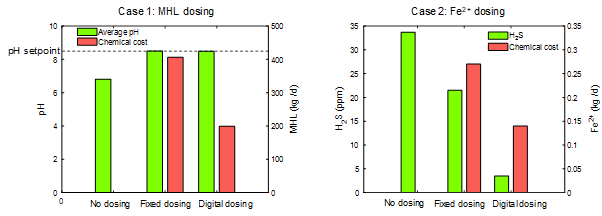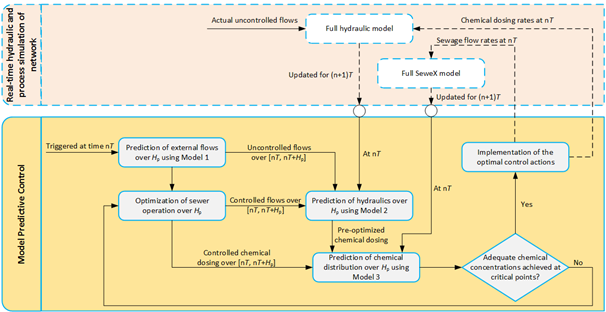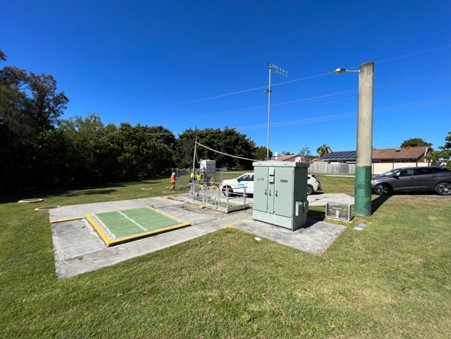Network-wide sewer odour and corrosion management by model predictive control
Overview
Network-wide sewer corrosion and odour management is a highly challenging task due to the lack of suitable methodologies to support the control designs of chemical dosing units and sewage pumping stations. This project aims to develop and demonstrate, through real-life field studies, a model predictive control approach that achieves cost-effective network-wide mitigation of hydrogen sulfide. The innovative control methodology involves the simultaneous manipulation of chemical dosing unit(s) and selected sewage pumping station(s), based on real-time prediction of sewage flows and characteristics both at sources and across the network, to ensure optimal delivery of dosed chemicals to realise network-wide mitigation of hydrogen sulfide.

Project Outcomes
This project addresses a very important, long-lasting problem in urban water system management. Hydrogen sulfide-induced sewer corrosion causes major asset loss. Thus, Australian water industry has to undertake frequent inspections and maintenance. Costing Australian water industry hundreds of millions of dollars annually, sewer odour and corrosion add a burden to residential water bills. Sulfide released to the atmosphere may also cause nuisance odour, affecting nearby residents. The advanced control algorithm is applicable for dosing different chemicals in sewer networks comprising both rising mains and gravity sewers, to mitigate sulfide-induced sewer corrosion and odour issues.
This project provides smart tools for ongoing maintenance and management of the sewer integrity and proper functioning for wastewater conveyance. This project developed a novel approach to integrate three predictive models and one operation optimization algorithm to achieve network-wide control of hydrogen sulfide in sewers. The three mathematical models are used to predict the sewage flow rates entering the network, the hydraulic characteristics in the network and the chemical distribution in the network, respectively. The optimization algorithm then searches for an optimal operation of the chemical dosing stations and selected sewage pumping stations (SPS) to minimize hydrogen sulfide across the whole network. This project will fill in a major technology gap in sewer corrosion and odour management. In practical application, it also established efficient and low-cost IoT system: 1) wireless big data transmission; 2) cloud computing for large-scale computation; 3) parallel computing at high-performance computer; 4) remote control rather than local PLC; 5) secure systems without communication with SCADA.
This project enables non-specialists to automatically design intelligent control strategy for confident sewer protection. This digital product effectively reduces sewer corrosion to avoid unnecessary major capital works, thus achieving significant economic and environmental benefits. It will maximise the service life of sewer infrastructure for safe wastewater management, release operators from working in hazardous circumstances, and bring cost savings in the order of hundreds of millions of dollars annually once the technology is widely taken up across Queensland. Effective control of nuisance odour and toxic gas will reduce the level of annoyance and complaints in the community.
Knowledge transfer
This project successfully demonstrated the world’s first real-time control system for chemical dosing in two real-life sewer networks.
- Case 1 (2 months in Winter): Mg(OH)2 dosing was controlled online in a sewer network operated by City of Gold Coast serving ~8500 residents. The digital dosing achieved stable pH of 8.49±0.26 (setpoint is 8.5), with dosage being reduced close to the theoretical minimum.
- Case 2 (6 months in Summer/Autumn): FeCl2 dosing to a sewer network in Brisbane serving ~13000 residents. Sulfide mitigation improved by 84% with 49% chemical savings compared to the profiled method.
This project provides sufficient smart solutions for the management of hydrogen sulfide in sewer networks and greatly reduces both the operational cost and time cost for decision making. The developed control strategy, predictive models, and optimisation algorithm can potentially be applied to real-time control of sewer overflow minimisation, integrated control of urban water systems, and other prospects of smart cities.
Funding
- City of Gold Coast
- SA Water
- Urban Utilities
- Australian Research Council
- The University of Queensland
Collaborators
- City of Gold Coast
- Urban Utilities
- SA Water
Publications
Papers
- Li, J., Sharma, K., Li, W. and Yuan, Z. (2022) Swift Hydraulic Models for Real-time Control Applications in Sewer Networks. Water Research 213, 118141.
- Li, J., Li, W., Chang, X., Sharma, K. and Yuan, Z. (2022) Real-Time Predictive Control for Chemical Distribution in Sewer Networks using Improved Elephant Herding Optimization. IEEE Transactions on Industrial Informatics 18(1), 571-581.
- Yuan, Z., Olsson, G., Cardell-Oliver, R., van Schagen, K., Marchi, A., Deletic, A., Urich, C., Rauch, W., Liu, Y., and Jiang, G. (2019). Sweating the assets–the role of instrumentation, control and automation in urban water systems. Water Research 155, 381-402.
- Li, J., Sharma, K., Liu, Y., Jiang, G. and Yuan, Z. (2019) Real-time prediction of rain-impacted sewage flow for on-line control of chemical dosing in sewers. Water Research 149, 311-321.
- Ganigué, R., Jiang, G., Liu, Y., Sharma, K., Wang, Y. C., Gonzalez, J., ... & Yuan, Z. (2018). Improved sulfide mitigation in sewers through on-line control of ferrous salt dosing. Water Research 135, 302-310.
- Liu, Y., Ganigué, R., Sharma, K. and Yuan, Z. (2016) Event-driven model predictive control of sewage pumping stations for sulfide mitigation in sewer networks. Water Research, 98, 376-383.
Conference proceedings
- Li, J., Sharma, K., Smith, P., Johnson, I., Yuan, Z. Optimisation of chemical dosing in sewer networks through Internet of Things. Ozwater2024. Melbourne, Australia, 2024.
- Li, J. Sustainable Protection of Sewer Networks Through Internet of Things. 5th IWA Resource Recovery Conference. Shenzhen, China, 2023.
- Li, J., Sharma, K., and Yuan, Z. Swift Computation of Hydraulic Characteristics in Sewer Networks. 11th IWA Symposium on Modelling and Integrated Assessment, Québec City, Canada, 2023.
- Li, J. Real-time optimisation of chemical dosing for odour and corrosion management in sewer networks. 3rd International Symposium on Sustainable Urban Drainage, Jiashan, China, 2023.
- Li, J., Li, W., Sharma, K., and Yuan, Z. Network-wide control of sewer corrosion and odour by optimization of chemical dosing. World Water Congress & Exhibition of the International Water Association (IWA). Copenhagen Denmark, 2022.
- Li, J., Sharma, K., and Yuan, Z. Real-time optimisation of sulfide control by dosing ferrous salt in sewer networks. 7th IWA Water Resource Recovery Modelling Seminar. Arosa, Switzerland, 2021.
- Li, J., Sharma, K., and Yuan, Z. Event-triggered online control of chemical dosing for sulfide mitigation in sewer networks. International Conference on Urban Drainage. Melbourne, Australia, 2021.
- Li, J., Sharma, K., Liu, Y., Jiang, G. and Yuan, Z. Real-time prediction of rain-impacted sewage flow for on-line control of chemical dosing in sewers. 10th IWA Symposium on Modelling and Integrated Assessment. Copenhagen Denmark, 2019.
Other Members
- Dr Keshab Sharma




